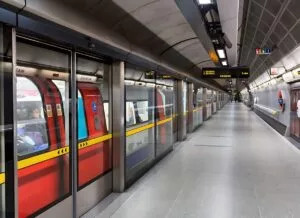
In contemporary metro stations all around the globe, platform screen doors typically limit
people’s access to the rails and passageways. In addition, the signalling mechanism and all
platform screen gates are interlocked to restrict the trains from leaving when gates are not shut
and secured.
Furthermore, each bi-parting gate features an emergency release system that allows train
passengers to slide through the openings in case of a malfunction physically. Modernised
platform screen doors include more windows, are ergonomically designed, and have an up-to-
date appearance. Moreover, they make less noise whenever the doors are opened.
Green summary indication lamps are installed at both sides of the station in contemporary platform
screen door arrangements, and they light up when all gates are completely closed and latched.
Platform screen doors vary in size; some may extend only some of the way to the top.
These doors, called partial screens and platform edge entryways, are typically higher than trains but
have an open top. Several advantages of wide gates are conveyed by these, although often at a
reduced total cost. Conversely, platform gates are often just about waist height. Accident
prevention is their primary goal; deliberate jumping and trashing are still feasible in this setup.
Design of a PSD mechanism autonomous of signalling. Visit our home page : Aurotoshi

The base level elements and the hijack and control unit make up the conventional design of
such a PSD system that is signalling agnostic. At the component level, a PSD model generally
consists of the following components:
● Structure: Engineered to provide attachment points for such covers, header units, doors,
and panelling and reliably withstand the stipulated loadings.
● A glass that has been laminated together uses a plastic intermediate to permanently link
multiple pieces of glass.
● Automated platform moving doors are a natural wall set at the platform’s outermost point
and are timed to open with the train’s inside door.
They provide a variety of benefits, some of which include raising station ambience and
promoting safety.
Preventing accidents platform screen doors:
Platform screen doors guard against unintentional falls into the bottom track area. It aids in
reducing accidents and fatalities in the transit system. They also stop murders committed by
one person pushing another into the rails and attempted suicides. Lastly, they can aid in
preventing falls on the station by minimising the degree of wind brought on by the pistons effect,
wherein trains going through the tunnel generate a powerful air current.
Keeping trains on track:
PSDs can reduce service interruptions brought on by track invasion by preventing unauthorised
access to railway lines. A system of interconnecting is in effect to prevent early departures, and
the signals system is also connected with the PSDs. This implies that the train will only be
allowed to leave the station if any doors are found to be shut and secured.
Climate Management on a Platform
Particularly in the case of full-size PSD, the station climate management is carried out by
isolating the platform region from the passage. The platform climate could be controlled entirely
as a result of this. Sure, it would be anticipated that less energy should have been used for
warming (in a cold region) or conditioning (in a hot region).
It’s because air passing through the passageways would not mingle with the ventilation system on the station. Furthermore, the platform doors significantly minimise the area that requires temperature control.
Role of Heating and Cooling:
According to the location of the PSD, this feature includes an integrated heating or conditioning
component inside the PSD to assist with platform air conditioning. This is especially helpful in
decreasing the heating/cooling units that need to be put on the platform, providing more benefits
with less concern for where to place the air control units inside the platform environment.
What use do platform screen doors serve in the final, specifically?
These platform screen doors have a variety of functions along with several advantages. Let’s
look at these functions –
● To prohibit foreign objects from falling into the existing railway area and interfering with
the train’s regular operation by preventing passengers from wandering into these areas
or intentionally entering the machinery region.
● Screen doors provide a sound-insulating effect that can lessen the level of noise that can
be heard.
● To give the station structural stability, certain unique Elements were created.
● There are half-height or full-height station screen gates of the terminals at certain
elevated stations and others on the level.
● Provide simple mobilisation for peak transit & station passenger traffic.
Why Must We Use Platform Screen Doors?
Platform screen gates must be installed to safeguard millions of passengers who utilise public
transportation systems worldwide. Public transit in cities offers an affordable and effective
means of mobility. However, these networks may be highly congested, resulting in catastrophic
disasters. Platform screen doors offer the peace of mind that travellers need.

